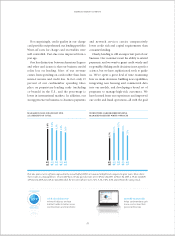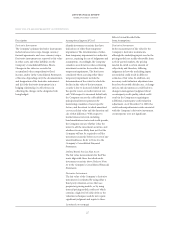American Express 2009 Annual Report Download - page 22
Download and view the complete annual report
Please find page 22 of the 2009 American Express annual report below. You can navigate through the pages in the report by either clicking on the pages listed below, or by using the keyword search tool below to find specific information within the annual report.
2009 FINANCIAL REVIEW
AMERICAN EXPRESS COMPANY
further expects these write-offs in the second quarter of 2010
to be lower than the first quarter.1
In 2010, the Company intends to invest a substantial
portion of expected benefits from its improving credit
performance. The Company will focus on launching new
products and services, improving long-term margins with
investments in infrastructure, and driving growth for the
moderate to long-term. As the Company continues to scale
back its issuance of proprietary lending cards and targets
more premium cards, the Company’s priority will be to drive
billed business and average spend per card rather than achieve
broad growth in cards-in-force.
The Company’s net interest yield in 2009 was impacted by
re-pricing actions, the Credit Card Accountability
Responsibility and Disclosure Act (CARD Act), and changing
consumer behavior. Going forward, these same dynamics will
apply, with more impact from the CARD Act expected in the
future. As such, the Company expects net interest yields to
trend down closer to historic levels over time.
The Company expects its 2010 EPS growth to be well
above its long-term EPS target of 12 percent to 15 percent.
REENGINEERING INITIATIVES
In the fourth quarter of 2008, the Company announced
various reengineering initiatives which were expected to
produce cost benefits of approximately $1.8 billion in 2009
versus the previously anticipated spending levels. These
initiatives included: reducing staffing levels and compensation
expenses (expected benefits of $700 million in 2009), reducing
certain operating costs (expected benefit of $125 million in
2009) and scaling back investment spending (expected benefit
of $1.0 billion in 2009). The Company began the execution
and implementation of these initiatives in the fourth quarter
of 2008, and as such, recorded a fourth quarter of 2008
restructuring charge of $404 million ($262 million after-tax)
in continuing operations, primarily associated with severance
and other costs related to the elimination of approximately
7,000 positions, in addition to $17 million ($11 million after-
tax) of other net reengineering costs.
In the second quarter of 2009, the Company announced
another phase of reengineering initiatives which were
1The “managed basis” presentation includes on-balance sheet
cardmember loans and off-balance sheet securitized cardmember
loans. The difference between the “owned basis” (GAAP)
information and the “managed basis” information is attributable
to the effects of securitized activities. The Company is not
presenting estimates of owned net write-off rates comparable to
the managed data above because the owned net write-off rates are
not determinable at this time. For further discussion of the
Company’s owned and managed basis presentation, refer to the
information set forth under U.S. Card Services in the section
captioned “Differences Between GAAP and Managed
Presentations”.
expected to produce incremental cost benefits of
approximately $800 million in 2009. These initiatives
included: reducing staffing levels and compensation expenses
(expected benefit of $175 million in 2009), scaling back
investment spending on marketing and business development
(expected benefit of $500 million in 2009) and cutting certain
professional services, travel and general overhead expenses
(expected benefit of $125 million in 2009). The Company
began the implementation of these initiatives in the second
quarter of 2009, and as such, recorded a second quarter 2009
net reengineering charge of $182 million ($118 million after-
tax) in continuing operations, primarily associated with
severance and other costs related to the elimination of
approximately 4,000 positions. Cumulatively, through these
reengineering initiatives, the Company expected to eliminate
approximately 11,000 positions, which accounted for
approximately 17 percent of its global workforce as of
September 30, 2008.
As the Company has previously indicated, business results
in the second half of 2009 have been stronger than initially
forecasted primarily due to favorable credit and business
trends. The benefits from these favorable trends have been
utilized to increase spending on marketing and other
business-building initiatives during the latter part of 2009.
These increased investments have in turn reduced the targeted
savings from our reengineering initiatives of approximately
$2.6 billion described above. These favorable trends also
drove other business changes and modifications to previously
planned reengineering initiatives which have resulted in a
lower level of employee staff reductions and higher employee
redeployment to other positions in the Company, further
reducing targeted savings. As of December 31, 2009, employee
count has declined 8,200 or 12 percent since September 30,
2008 primarily due to the above initiatives.
ACQUISITIONS
On January 15, 2010, the Company purchased Revolution
Money, a provider of secure person-to-person payment
services through an internet based platform, for
approximately $300 million. Revolution Money offers online
person-to-person payment accounts that are FDIC insured
and suited for social and instant messaging networks and
offers the RevolutionCard, a general-use PIN-based card with
enhanced security. The Company believes that Revolution
Money’s assets and expertise complement both its existing
payments and processing capabilities, and also provides it
with an innovative technology platform which can help
extend the Company’s leadership beyond the traditional
payments arena.
On March 28, 2008, the Company purchased Corporate
Payment Services (CPS), General Electric Company’s
commercial card and corporate purchasing business unit. The
Company acquired $2.2 billion in assets and assumed $63
million in liabilities. The total cash consideration of $2.3
20
























